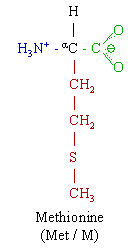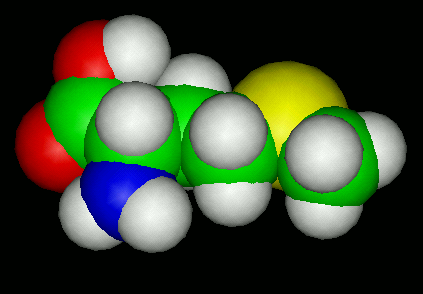Symbol:Met M
Molecular Weight: 149.21
Isolectric point (pH) 5.74
Molecular Formula: C 5H11NO2
S

Methionine (Met, M. C5H11NO2S) is a essential nonpolar amino acid, and a lipotropic.
It and cysteine are the only sulfur containing amino acids that are coded for by DNA (Homocysteine is an amino acid and contains sulfur, but is a product of S-adenosylmethionine 1 carbon metabolism and is not coded for by DNA). Methionine is a methyl donor as S-adenosyl methionine (SAM). It is incorporated into the N-terminal position of all proteins in eukaryotes and archaea, though it may be removed by post-translational modification (bacteria incorporate N-formyl methionine instead). Methionine can also occur at other positions in the protein. It plays a role in cysteine, carnitine and taurine synthesis by the transsulfuration pathway, lecithin production, the synthesis of phosphatidylcholine and other phospholipids. Improper conversion of methionine can lead to atherosclerosis. Methionine is a chelating agent.
Most amino acids have a redundant genetic code; several different nucleotide sequences code for the same amino acid, giving a degree of error-correction to the genetic sequence, usually with the third base in the codon being non-specific. Methionine is one of only two amino acids with a single codon, AUG. (Tryptophan, encoded by UGG, is the other)

